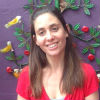On Yom HaShoah, Holocaust Remembrance Day, it is our job as teachers to ensure that the memory of the Holocaust is not forgotten. It is our hope, as a society, that the preservation of these memories will prevent these events from happening again, any place in the world, and that the words of the survivors will ring out as alarm bells today.
Using testimony in the classroom is a way to personalize the story of the Holocaust for students. It can help them understand that although it was a collective trauma, it was different for every individual who lived through that time period. Every experience was tempered by place, time, and personal circumstance. Survival depended on so many factors, most of which are unquantifiable.
Here are four ways you can bring the testimony and memories of survivors into your classroom to spark discussions with your students on Yom HaShoah.
A self-portrait by Holocaust survivor, Samuel Bak.
- Video Testimony: Many schools are still able to bring in survivors to tell their story in person but as time goes on, this becomes harder and harder. One way to bring the voice of a survivor into the classroom and create a connection is through video testimony using tools from Facing History’s partner, USC Shoah Foundation – The Institute for Visual History and Education. IWitness helps educators access more than 1,500 video testimonies of survivors and witnesses to the Holocaust and other genocides.
- Written Testimony: Our resource, Teaching Salvaged Pages: Young Writers' Diaries of the Holocaust, provides primary sources and lesson plans for language arts and history teachers to complement Alexandra Zapruder's award winning collection of diaries written by young people during the Holocaust. These young writers came from a broad spectrum of differing experiences - some hid or attempted to pass as non-Jews, some were imprisoned, and some were refugees, reminiscent of the ones we see in today’s news. They wrote to preserve a sense of self while the world they inhabited sought to destroy it. These stories can be used in the classroom to understand the diverse experiences of young people during the Holocaust.
- Jewish Partisan Testimony: Too often, students of the Holocaust are left with the impression that Jews were simply helpless victims, lacking the courage or means to fight back. The Jewish Partisan Educational Foundation counters this misconception by bringing to life the experiences of the Jews who formed or joined resistance brigades across ten European countries to fight the Germans and their collaborators through interviews, multimedia curricula, short films, and lesson plans. Stay tuned for an exciting announcement from Facing History about this important part of history. In the meantime, check out the amazing individual experiences of the partisans and other examples of resistance including religious, social and political actions.
- Testimony through Art: Art can be an interesting conversation starter with your students. Use artwork, like the paintings of Holocaust survivor, Samuel Bak, to enrich your discussion and sharpen your students’ critical thinking skills about the power of memory and testimony. Facing History’s resources on Samuel Bak and teaching strategies for analyzing a visual image offer interactive and thoughtful ways to use art in your classroom.
Whatever way you decide to use testimony, consider these questions and activities to further the conversation:
- Ask your class: Why is it important for us as individuals to listen to the stories of survivors? Why is it important for us as a society to listen to these stories? Find the places where these overlap. Where are they different?
- After using testimony: have the students participate in a big paper silent conversation activity in small groups. What questions, both specific and open ended, do the testimonies raise for us as individuals? What questions do they raise for us as a society?
These resources and teaching strategies can help foster reflective and respectful conversations with your students about the importance of memory, testimony, and how students’ individual choices have an impact on society as a whole.


